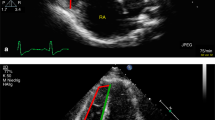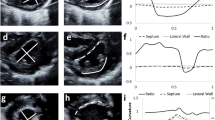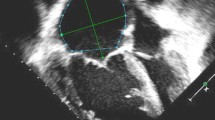Abstract
Changes in ventricular geometry are often seen in patients with right ventricular hypertension secondary to pulmonary hypertension (PH). Progressive systolic bowing of the inter-ventricular septum occurs with increasing right ventricular pressure (RVp) and can be quantified with the left ventricular end-systolic eccentricity index (LVEI). Only limited data exist in children to evaluate the relationship between the LVEI and invasive RVp. We sought to assess the correlation between the LVEI and an invasively measured peak systolic RVp to aortic pressure (pAo) ratio. Medical records of patients undergoing echocardiography within 30 days of right and left heart catheterization for evaluation of PH between February 2009 and March 2014 were retrospectively reviewed. Forty-six studies in 29 subjects (median age 3.8 years, 46 % female), with a median time from echocardiogram to catheterization of −1.0 days, were included for analysis. The mean LVEI was 1.6 ± 0.5, and mean RVp/pAo ratio was 0.68 ± 0.26. There was a significant positive correlation (r = 0.76, p < 0.001) between LVEI and RVp/pAo ratio. ROC analysis demonstrated an area under the curve = 0.91 for prediction of RVp/pAo >0.50 by the LVEI. An LVEI >1.48 had a sensitivity of 76 % and specificity of 100 % in predicting RVp/pAo >0.50, while an LVEI >1.24 had a sensitivity of 88 % and specificity of 83 %. Echocardiographically derived LVEI is strongly correlated with invasively determined RVp/pAo ratio. In combination with other noninvasive measures of RVp, LVEI may help minimize the need for invasive patient evaluation.




Similar content being viewed by others
References
Alkon J, Humpl T, Manlhiot C, McCrindle BW, Reyes JT, Friedberg MK (2010) Usefulness of the right ventricular systolic to diastolic duration ratio to predict functional capacity and survival in children with pulmonary arterial hypertension. Am J Cardiol 106:430–436
Carmosino MJ, Friesen RH, Doran A, Ivy DD (2007) Perioperative complications in children with pulmonary hypertension undergoing noncardiac surgery or cardiac catheterization. Anesth Analg 104:521
Cunningham JW, McElhinney DB, Gauvreau K, Bergersen L, Lacro RV, Marshall AC, Smoot L, Lock JE (2013) Outcomes after primary transcatheter therapy in infants and young children with severe bilateral peripheral pulmonary artery stenosis. Circ Cardiovasc Interv 6:460–467
Feneley M, Gavaghan T (1986) Paradoxical and pseudoparadoxical interventricular septal motion in patients with right ventricular volume overload. Circulation 74:230–238
Fisher MR, Forfia PR, Chamera E, Housten-Harris T, Champion HC, Girgis RE, Corretti MC, Hassoun PM (2009) Accuracy of Doppler echocardiography in the hemodynamic assessment of pulmonary hypertension. Am J Respir Crit Care Med 179:615
Jone P-N, Hinzman J, Wagner BD, Ivy DD, Younoszai A (2014) Right ventricular to left ventricular diameter ratio at end-systole in evaluating outcomes in children with pulmonary hypertension. J Am Soc Echocardiogr 27:172–178
Kassem E, Humpl T, Friedberg MK (2013) Prognostic significance of 2-dimensional, M-mode, and Doppler echo indices of right ventricular function in children with pulmonary arterial hypertension. Am Heart J 165:1024–1031
King M, Braun H, Goldblatt A, Liberthson R, Weyman A (1983) Interventricular septal configuration as a predictor of right ventricular systolic hypertension in children: a cross-sectional echocardiographic study. Circulation 68(1):68–75
Lammers AE, Haworth SG, Riley G, Maslin K, Diller G-P, Marek J (2012) Value of tissue Doppler echocardiography in children with pulmonary hypertension. J Am Soc Echocardiogr 25:504–510
Lopez L, Colan SD, Frommelt PC, Ensing GJ, Kendall K, Younoszai AK, Lai WW, Geva T (2010) Recommendations for quantification methods during the performance of a pediatric echocardiogram: a report from the pediatric measurements writing Group of the American Society of Echocardiography pediatric and congenital heart disease council. J Am Soc Echocardiogr 23:465–495
López-Candales A, Rajagopalan N, Kochar M, Gulyasy B, Edelman K (2008) Systolic eccentricity index identifies right ventricular dysfunction in pulmonary hypertension. Int J Cardiol 129:424–426
Malhotra SP, Hanley FL (2009) Surgical management of pulmonary atresia with ventricular septal defect and major aortopulmonary collaterals: a protocol-based approach. Semin Thorac Cardiovasc Surg Pediatr Card Surg Annu 12(1):145–151
Mazurek JA, Forfia PR (2013) Enhancing the accuracy of echocardiography in the diagnosis of pulmonary arterial hypertension: looking at the heart to learn about the lungs. Curr Opin Pulm Med 19(5):437–445
O’Byrne ML, Glatz AC, Hanna BD, Shinohara RT, Gillespie MJ, Dori Y, Rome JJ, Kawut SM (2015) Predictors of catastrophic adverse outcomes in children with pulmonary hypertension undergoing cardiac catheterization: a multi-institutional analysis from the pediatric health information systems database. J Am Coll Cardiol 66:1261–1269
Reisner SA, Azzam Z, Halmann M, Rinkevich D, Sideman S, Markiewicz W, Beyar R (1994) Septal/free wall curvature ratio: a noninvasive index of pulmonary arterial pressure. J Am Soc Echocardiogr Off Publ Am Soc Echocardiogr 7:27
Rich JD, Shah SJ, Swamy RS, Kamp A, Rich S (2011) Inaccuracy of Doppler echocardiographic estimates of pulmonary artery pressures in patients with pulmonary hypertension implications for clinical practice. CHEST J 139:988–993
Ryan T, Petrovic O, Dillon JC, Feigenbaum H, Conley MJ, Armstrong WF (1985) An echocardiographic index for separation of right ventricular volume and pressure overload. J Am Coll Cardiol 5:918–924
Schena M, Clini E, Errera D, Quadri A (1996) Echo-Doppler evaluation of left ventricular impairment in chronic cor pulmonale. Chest 109(6):1446–1451
Sirnes PA, Tendera M, Vardas P, Widimsky P (2009) Guidelines for the diagnosis and treatment of pulmonary hypertension. Eur Heart J 30:2493–2537
Taylor C, Derrick G, McEwan A, Haworth S, Sury M (2007) Risk of cardiac catheterization under anaesthesia in children with pulmonary hypertension. Br J Anaesth 98:657–661
Testani JM, St John Sutton MG, Wiegers SE, Khera AV, Shannon RP, Kirkpatrick JN (2010) Accuracy of noninvasively determined pulmonary artery systolic pressure. Am J Cardiol 105:1192–1197
Watson T, McCracken CE, Slesnick T, Kanaan U, Border WL, Sachdeva R (2015) Quantitative assessment of ventricular septal contour for estimation of right ventricular pressure. Echocardiography
Yared K, Noseworthy P, Weyman AE, McCabe E, Picard MH, Baggish AL (2011) Pulmonary artery acceleration time provides an accurate estimate of systolic pulmonary arterial pressure during transthoracic echocardiography. J Am Soc Echocardiogr 24:687–692
Author information
Authors and Affiliations
Corresponding author
Ethics declarations
Conflict of interest
The authors do not have any conflicts of interest to report.
Rights and permissions
About this article
Cite this article
Averin, K., Michelfelder, E., Sticka, J. et al. Changes in Ventricular Geometry Predict Severity of Right Ventricular Hypertension. Pediatr Cardiol 37, 575–581 (2016). https://doi.org/10.1007/s00246-015-1317-z
Received:
Accepted:
Published:
Issue Date:
DOI: https://doi.org/10.1007/s00246-015-1317-z




